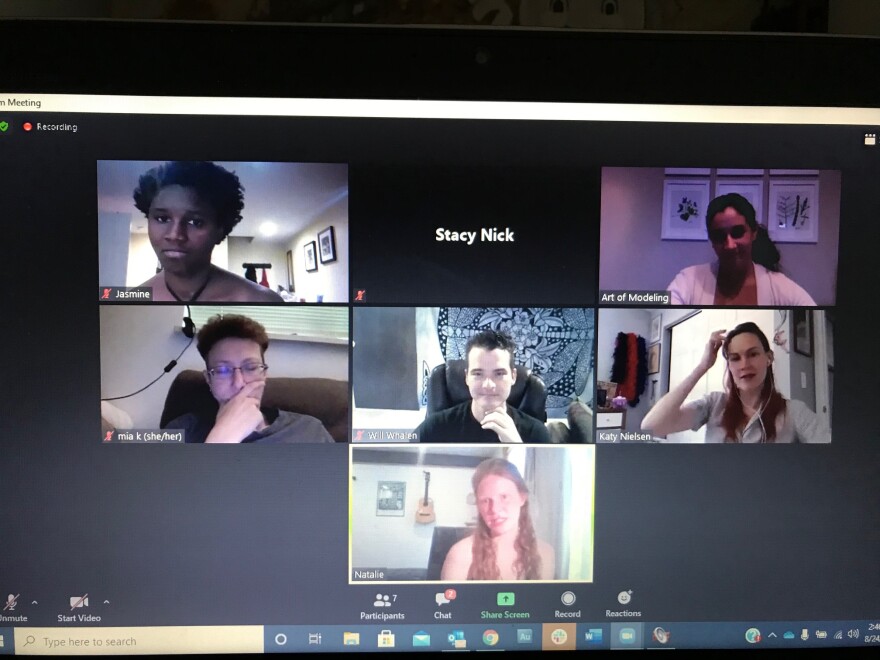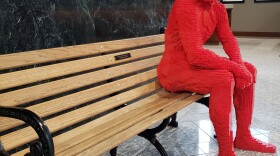Ellen Allen is the owner of the Art of Modeling, a Boulder-based booking agency for fine art models. And she doesn’t mince words when talking about what going virtual has meant for her business.
“As far as being an artist, it’s not the same, at all. I mean, it’s not three-dimensional and that’s what we want to learn how to draw,” Allen said. “So it’s a pretty bunk offering, overall.”
Allen started the business almost two years ago out of her apartment and was just beginning to see some success. She had a solid roster of models and clients. Then the pandemic hit in March. During the first few weeks of the shutdown she lost more than 100 scheduled bookings.
“Mid-April I finally came to terms with the fact that, as much as I hate technology, I needed to probably do something to try to keep my models working,” she said.
Over the spring and summer Allen has done some in-person, “plein air” (i.e. outdoor) events. But with fall fast approaching her work is going more and more the way everything else has in 2020: onto Zoom.

Going virtual means a recent model training class was able to cast a wider net. Allen now has a model who does Zoom sessions from Turkey, and one of her newest clients is the University of Texas at Austin.
Still, Allen said only about half of her models have signed on to do virtual sessions — largely due to technical difficulties. Either they don’t have a camera in their computer or the one they have offers up too grainy of an image for artists to sketch from. Others are not tech savvy enough to navigate virtual modeling.
Most artists haven’t been too keen on it either. About 90 percent of Art of Modeling’s jobs pre-COVID were for nude models, Allen said. Because artists want to draw the human form.
But Zoom doesn’t allow nudity, so models are “lightly clothed.” It also means the models — and not the artists — are in charge of things like setting the subject angles.
“You become the lighting director, and the backdrop director a lot more than when you just go to the studio and they have it set up,” said model Katy Nielsen, adding that like many new to working from home, she’s also discovered some unexpected perks.
“It was a little more work, but it was also awesome because on the breaks I could go throw my laundry in,” Nielsen said.
And just like many office virtual meetings, pets have a habit of Zoom bombing sessions.
“My cat came into the screen a few times during the University of Austin and they were really amused,” Nielsen said. “The teachers (joked), 'oh look, an extra bonus figure! Everybody if you want to draw the cat.'”

Nielsen says the one place where Zoom sessions might actually surpass in-person events is in the portrait world. The camera allows artists to get up-close images they wouldn’t otherwise be able to easily access.
“I’ve definitely been in studios before where people will bring binoculars,” she said. “I’ve seen people looking at me with binoculars from the floor to get details.”
For models, there is a performance aspect that virtual will never be able to replicate, she added. Like when Nielsen, who also works as an actress, posed for a recent live pop-up session in which the models wore costumes.
“It was great and I got to be David Bowie,” she said. “It was the closest thing I’ve had to a performance in months!”
And while there’s no more setting out a physical tip jar at events, models now list their Venmo and PayPal accounts to accept tips.
But for some models, the Zoom boom has been less than ideal.
Daniel Peters is 59, and has been with Art of Modeling almost since it began, but his only virtual session so far was a rough one
“I did one back in April, which was a test, and it kind of failed miserably because of technology,” Peters said. “We did Skype. I ended up only getting one artist on the Skype session. So that’s basically my extent of modeling online and virtual. It’s been pretty much non-existent.”
Peters wants to get back to in-person modeling as soon as possible, but he and his wife are both immunocompromised. Although fine art modeling, he says, is probably one of the safest jobs out there at the moment.

“It’s not a worry to me if we’re in a closed space and people are wearing masks and they’re social distancing because it’s kind of been social distancing all along,” he said.
And a “nude” model donning only a mask during a session might make for an interesting subject for artists to document, Peters said.
“If they wanted to include it in the drawing that’d be great because obviously this is a time that none of us has ever experienced, so it might be interesting to have a model posing with a mask on,” he said.
Peters found modeling later in life after becoming unemployed from his job as a sports photographer. He says it’s a good paying, flexible job that he can easily do and still take care of his wife, who is disabled. While jobs are in a lull, he’s considering taking on other gig work — like driving for Uber or a food delivery service — but hopes to get back to his favorite job soon.

“It feels more rewarding,” he said. “Everything I’ve done in my life — even the media stuff, that was rewarding but — I see the reward right away when you see the artwork that they do. So it’s something that I’ll always do until I can’t move anymore.”
While he believes younger artists will adapt to digital options, Peters believes that older, traditional artists will likely be slower to make the shift. He hopes that when this is all over, the in-person jobs will be back, and so will he.
“I think this whole year has been like a slap in the face to most people,” he said.
Art of Modeling owner Ellen Allen agrees, adding that the pandemic has forced everyone to step out of their comfort zone in order to keep going. In addition to creating a GoFundMe campaign to support the models, Allen is working to host regular virtual and outdoor events as possible.
“Although it’s just a tiny fraction of the normal amount of jobs, at least we’ve been able to provide about two dozen virtual and plein air bookings to our models to kind of string them through these hard times,” she said.






